HD660S2
back to Sennheiser
back to measurements
home
published: Apr-07-2023
NO SMOOTHING is applied to the shown plots. Most measurement sites have some smoothing applied which ‘irons flat’ sharp peaks and ‘wiggles’. I do not use smoothing because some info about sound quality is lost when plots are smoothed.
Aside from a small correction of the microphone itself also some correction in the lowest frequencies is applied to the plots to compensate for the perceived loss of bass when using headphones. This is described HERE in more detail.
A ‘horizontal‘ frequency response curve on the shown frequency response plots on this website thus indicates a perceived ‘flat’ tonal signature.
ALL measurements are made with a good SEAL on a pinna-less flat-bed measurement rig.
The shape of your head, bone structure, pad size, pad ‘softness, (compliance), hair or no hair and or wearing glasses may (drastically) change the frequency response of some headphones, so… your personal experience may differ substantially from these plots.
Frequency response (tonal balance) is the most sound-determining aspect of headphones. A horizontal line shows audible neutral response in the plots on this website. Deviations in different severity at different frequency bands have an effect on the sound character.
The bigger the deviation the stronger the effect.
Below an aid to help determining the sound character of headphones with relation to the frequency response.
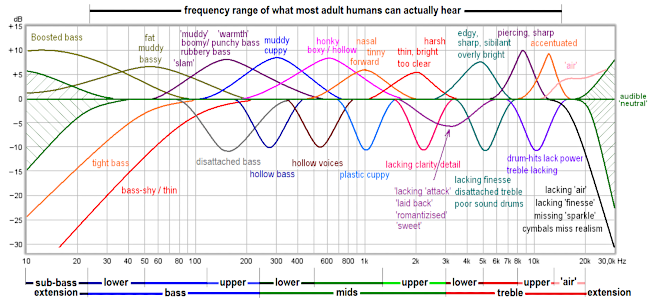
Sennheiser HD 660S2

The Sennheiser HD 660S2 is an open over-ear headphone. It was launched in February 2023. It sells for around €600.- which is a pretty high price. It is positioned between the HD600 and HD800S.
It is the successor of the, not very popular, and €100.- cheaper HD660S.
It has the same build as the decades old HD6** series. Just a bit more modern looking grilles and it comes with an extra cable using Pentaconn 4.4mm TRRRS cable. The matte black looks with rose-gold lettering gives it a fancy look, quite different from the HD600 and HD650. At first glance the only difference between the HD660S and HD660S2 seems to be in the colors used for the lettering and logo. There are, however, some changes in the internals as well.
It is manufactured in Ireland.
The main complaints for the HD660S were lack of bass extension and lacking in clarity and being a bit ‘conservative’ on the treble level.
The HD660S seemed to address the main ‘complaints’ about the HD600 and HD650 (upper midrange emphasis) yet is often disliked for that change.
The HD660S2 is touted as an improved HD660S doubling the SPL at 20Hz and increasing the clarity above 5kHz.
The HD600 is found to be lacking in bass extension and too ‘clear’. The HD650 was fuller sounding (more midbass presence) and some found it too ‘midrange’ oriented.
The HD660S (to me) was a nice compromise. A bit fuller sounding than HD600 and a bit ‘tighter’ in the lows than HD650. The HD660S did not have the ‘brightness’ of the HD600 but was a bit more ‘laid-back’. As if one is listening to the music a bit further away. Of course there is no way any headphone can ever please everyone.
The headband padding is soft and covered with a black silky feeling cloth. The clamping force, right out the box, is quite high (6N) and seems higher than needed. It can be lowered (see further down the article) and most likely will get somewhat lower during usage anyway.
The height can easily be adjusted and the cups can be extended by a generous 60mm. It has a notched action and stays in place after adjustment. Because of this it will fit most head sizes.
The cups can swivel and tilt enough to ensure a good fit on all head sizes.
Comfort is determined by the pads mostly. There has to be enough room for a wide range of ear sizes, enough depth to accommodate for more protruding ears and a pleasant feel.
Sennheiser pads are generally found to be comfortable. This is no different on the HD660S2.
Internal height is 70mm and width is 35mm. Depth is 22mm. The used foam is feeling fairly firm. The cloth covering the foam feels soft and pleasant. These are the same pads as used on the other HD6** headphones. It weighs 226gr. which is pleasantly low.
The cable is replaceable and uses the familiar Sennheiser 2-pin connectors also seen on the HD6** range. L and R markings are embossed on the connector and are a bit hard to see. For vision impaired users the right side of the hinge is marked with 3 braille dots. No other R and L markings are found on the HD660S2.
The HD660S2 comes with 2 cables. One of them is a 1.8m twin cable with the familiar 6.3mm gold-plated connector. To connect the headphone to a 3.5mm TRS socket a 25cm conversion cable is supplied. Most headphone cables these days have a threaded 3.5mm TRS plug with a 6.3mm screw-on adapter which would be a more economical and sensible solution.
The second cable is a 1.8m long cable terminated in a gold-plated 4.4mm Pentaconn TRRRS cable. This cable is wired for balanced operation. Slowly more and more (higher end) amplifiers are equipped with these output connectors, often alongside the rather bulky and more common 4-pin XLR connector.
The cable is mildly mircrophonic so touching the cable is (mechanically) audible in both cups. Fortunately only when touching the cable near the cups.
There is little isolation from outside noises as this is an open headphone. People around you can hear what is playing and the user can still hear sounds within the room although slightly attenuated.
The drivers are 325Ω (DC resistance) and have a sensitivity of 105dB/V (efficiency: 100dB/mW). This is not very sensitive but allows you to play comfortable loud directly from a phone.
The HD660S had 150Ω impedance and had a higher sensitivity of 109dB/V. This was said to be an improvement over the 300Ω impedance and allowed it to play slightly louder on portable gear (phone, tablets etc).
Strangely enough the impedance is made higher again and sensitivity dropped down again with the promise of better sound quality. Marketing stuff only IMO.
The headphone comes in a simple cardboard box. 2 cables, a 3.5mm conversion cable, a soft carrying pouch made of the same material as the headband padding, a multi-language information folder, a small card stating it passed quality control. On opening the box a nasty chemical smell greets you (pad foam ?) Fortunately this disappears after a day or so.
specifications:
Type: Over ear, open
Usage: home.
Driver type: dynamic
Driver membrane diameter: 38mm
Pads: replaceable, velours with regular, firm foam.
Inner pad dimensions: oval shaped height: 70mm , width: 35mm, depth: 22mm
Fold-able: No
Headphone connector: Sennheiser 2-pin
Cable entry: dual sided (split cable)
Cable: 1.8m straight cable with 6.3mm gold-plated TRS jack
25cm converter cable 6.3mm TRS socket to 3.5mm TRS jack plug
1.8m straight cable with 4.4mm TRRRS gold-plated Pentaconn plug.
Power rating: 0.2W (assumed)
Max. Voltage: 8V (24Vpp)
Max. current: 25mA
Max. S.P.L. 123dB
Impedance: 325Ω (measured)
Efficiency: 100dB @ 1mW
Sensitivity: 105dB @ 1V
Weight: 226 g.
Clamping force: high (6N)
Color: Black with rose-gold lettering
Accessories: 2x cable, 3.5mm adapter cable, soft carrying bag, manual
Sound description:
Bass is present and of good (not colored) quality. Bass extension is lacking a bit. Do not expect a ‘full bodied’ and ‘bassy’ headphone. Instead it sounds rather ‘normal’. The sound is not ‘hyped’ anywhere.
Mids sound realistic and are not ‘bright’ or ‘overly dynamic’ but also not ‘boring’.
There is no ‘bloom’ in male voices. The upper mids are not shouty and are pleasantly ‘laid-back’ sounding without the feeling missing in clarity. Compared to some other headphones they do lack some clarity though. A matter of getting used to.
Treble is not hyped, peaky. No ‘splashy’ cymbals and ‘ethereal’ treble and also not rolled-off nor sibilant nor is there any sharpness, as is often found in a lot of headphones. Treble is smooth and ‘silky’ with just enough ‘air’ and detail. Soft, pleasant and delicate treble without any harshness in it would be a fitting description. What more can one ask for ?
A pleasant and slightly warmish-neutral and laid-back sound that does not ‘pop’ anywhere and does not do things ‘overly done’ but just right.
Stereo imaging is the same as all the other HD6** models and is stable and very well defined. Instruments are easy to place and do not ‘wander’ around in the stereo-image. I read/seen reviews where it is mentioned that the stereo image is wide. It isn’t wider nor narrower than HD600/HD650 to me.
The HD660Ss just does its job in a way that it cannot be faulted much and allows for a fatigue free and pleasant listening experience. The sound is not ‘remarkable’ or ‘special’ in any way which is a compliment. Unassuming but lovely sound.
measurements
Below the frequency response of the HD660S2 (Left, Right)
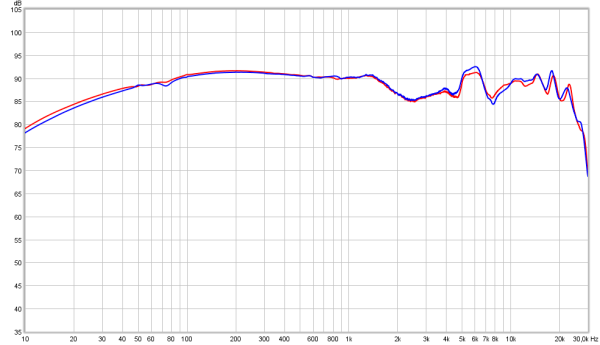
There (still) is a lack of sub-bass extension (below 40Hz) which is common in open headphones. Bass response 30Hz to 150Hz is not wonky nor elevated. The 1dB downwards tilt from 100Hz to 1.5kHz results in a slightly warm-ish tonality and good integration between bass and mids.
The small dip from 2kHz to 5kHz is responsible for the ‘laid-back’ sound and the somewhat subdued ,but not totally lacking in open-ness / forward-ness / dynamics.
The small elevation around 6kHz is too small to cause sibilance (pronounced ssss’es) and gives the HD660S2 just enough ‘bite’ as to not affect clarity too much. Treble response is extended to well above 20kHz and is not peaky nor has dips. Ingredients for a good and ‘smooth’ treble quality that is neither grainy nor sharp nor ‘hyped’.
compared to
Below a comparison between the HD660S2 and the predecessor HD660S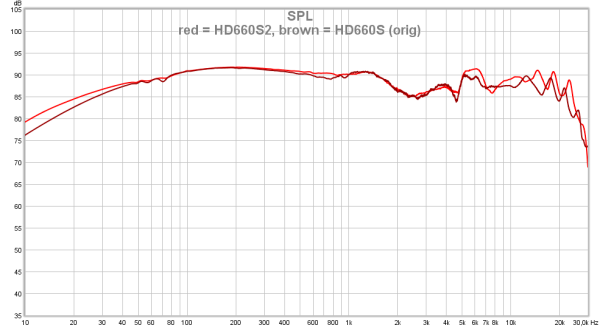 The HD660S2 has a hair better bass extension compared to a (very early) HD660S.
The HD660S2 has a hair better bass extension compared to a (very early) HD660S.
The, in the brochure suggested ‘doubling of SPL (+6dB @ 20Hz), is not met and only is +3dB but is audible in the sense that low rumbles are easier to hear. Bass level itself is not higher.
Also the treble response above 5kHz is just a few dB higher in level in the newer version resulting in comparatively more ‘sparkle’ and is also audible.
Below the HD660S2 compared to the older (black screen but new pads) HD650.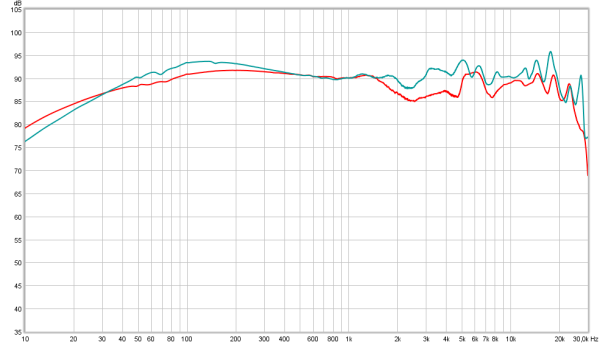 The HD660S2 does not have the midbass boost of the HD650 and is slightly better extended in the bass as well.
The HD660S2 does not have the midbass boost of the HD650 and is slightly better extended in the bass as well.
The biggest difference is in the 1.5kHz – 10kHz region. The HD650 is more ‘forward’ and ‘clearer’ compared to the ‘laid-back’ upper mids of the HD660S2.
Because of this the HD660S2 is a bit ‘tighter’ in the bass and a more ‘relaxed’ listen.
Treble of the HD660S2 is at a more correct level.
The difference in efficiency (about 3dB) is compensated for. The sensitivity of the HD660S2 is about 3dB higher (so plays marginally louder at the same volume control setting).
As the HD660S2 is priced between the HD600 and HD800S a comparison between a HD800S v.s. HD660S2 is also interesting.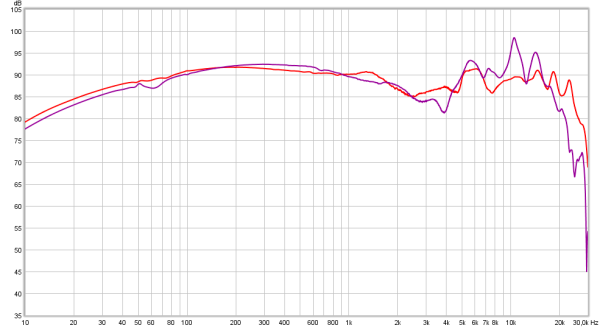 The HD660S2 is a bit more balanced in the bass. Both have a similar tonal character up to 5kHz.
The HD660S2 is a bit more balanced in the bass. Both have a similar tonal character up to 5kHz.
In the treble the HD800S is sharper sounding. However, what isn’t shown in this plot is the quite different comfort, room for the ears and above all details and stereo imaging. The HD800S is better in those aspects. Bass to mids is quite equal in quality. Note the ‘recess’ in the 3kHz range is similar as in the HD800S but because the HD800S driver is bigger in diameter, angled and further away from the ear, due to pinna-gain, the shown dip in the HD800S in this plot isn’t as deep as it looks on the plot.
Below the ‘cheap little brother’ or ‘poor man’s HD660’ the HD58X v.s. the HD660S2.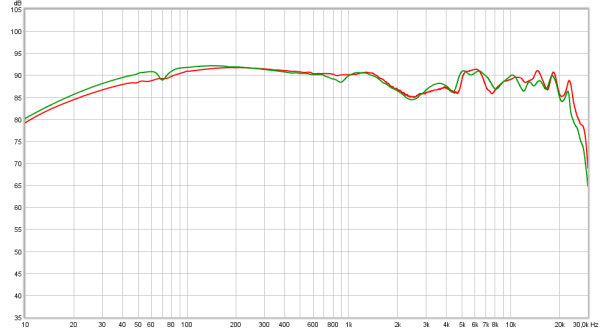 Yes… these measure quite similarly. The HD58X is even better extended. Still the HD660S2 is sounding ‘better’ in the lows and is more ‘refined’. The sensitivity of the HD58X is a bit higher though.
Yes… these measure quite similarly. The HD58X is even better extended. Still the HD660S2 is sounding ‘better’ in the lows and is more ‘refined’. The sensitivity of the HD58X is a bit higher though.
While tonally not that different the HD660S2 is technically better and more refined sounding.
Below, alternating every 5 seconds, the HD660S2 compared to several other open headphones. The plots have ‘acoustical smoothing’ applied to them to give a better idea of tonality differences.

Seal
Seal can be an issue with closed-back headphones. Breaking the seal (improper fit on the head) usually means a loss of (sub)bass. Seal breakage can be caused by different facial contours, glasses or hair between pads and head. Open headphones usually are much less seal dependent.
Below the effect of different levels of seal breach are shown .
Perfect seal, Seal broken with a pair of thick armed glasses resting against the skin, seal broken with a pair of thick armed glasses not resting against the skin (so a small gap between pad and skin). 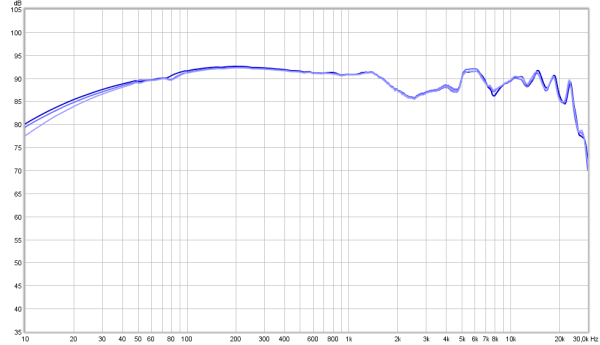 Different seal does not have any audible influence on the sound. Even low bass response is not affected. So a perfect seal is not needed nor of importance.
Different seal does not have any audible influence on the sound. Even low bass response is not affected. So a perfect seal is not needed nor of importance.
output resistance / damping-factor
As this is a dynamic headphone the frequency response might be amplifier output resistance dependent when certain higher output resistance amplifiers are used.
To test this the headphone is measured via an amplifier with output resistances of 0.2Ω, at 10Ω, 32Ω 120Ω. These traces are overlaid so tonal balance changes can easily be seen. On a higher output resistance amplifier the output level will be lower as well. The level drops 2.8dB at 120Ω.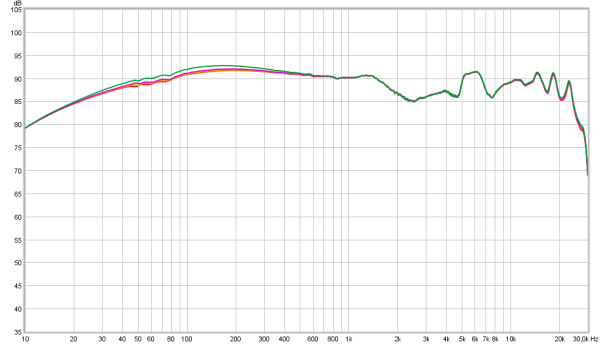
The output resistance of an amplifier has barely any influence on the sound. Only a 100Ω or higher (the output R of integrated amps or AVRs and some tube amps can be well above 100Ω) can cause a ,barely audible, increase in ‘warmth’.
Output resistances of up to 50Ω thus will not affect the overall sound.
Below the distortion measurements of the HD660S2 (right channel) @ 90dB SPL. The plot above is in a dB scale, below the same measurement but in a percentage scale.
The plot above is in a dB scale, below the same measurement but in a percentage scale. The distortion above 70Hz is quite low at 90dB SPL. Mids and treble is very clean.
The distortion above 70Hz is quite low at 90dB SPL. Mids and treble is very clean.
NOTE: The actual 2nd harmonic distortion above 100Hz may well be much lower than 0.2%.
A shortcoming (measurement limit) of my test fixture.
compression
As the 3rd harmonic distortion is very low in the distortion measurements there is very little compression seen in the drivers. The test below is the headphone measure 3 times but at 80dB, 90dB and 100dB SPL. These traces are then overlaid. When there is compression (drivers not being able to react linear to the applied voltage) this is shown by the frequency response dropping near the lower frequencies. As the effect is very, very small with the HD660S2 (indicating excellent linearity) the plot below has a 1dB/div scale. Only at 100dB SPL there is some (inaudible small) compression around the resonance frequency of the driver (centered around 80Hz). This is excellent. Measurements at 70dB and 60dB were the same as the 80dB trace so are not shown.
Measurements at 70dB and 60dB were the same as the 80dB trace so are not shown.
Time domain measurements
Below the phase response of the HD660S2. (Left, Right)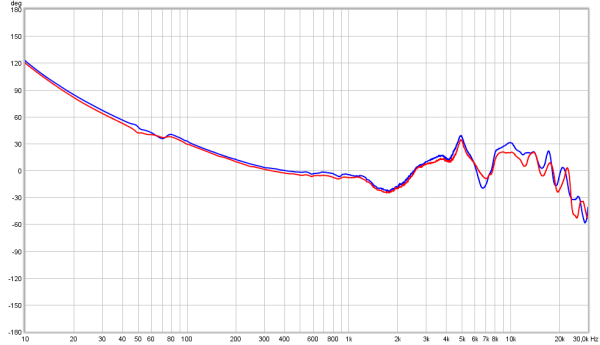 The phase response is almost exemplary. There are no substantial and narrow-band phase shifts anywhere.
The phase response is almost exemplary. There are no substantial and narrow-band phase shifts anywhere.
Below the Group Delay which can also show potential problem areas. (Left, Right)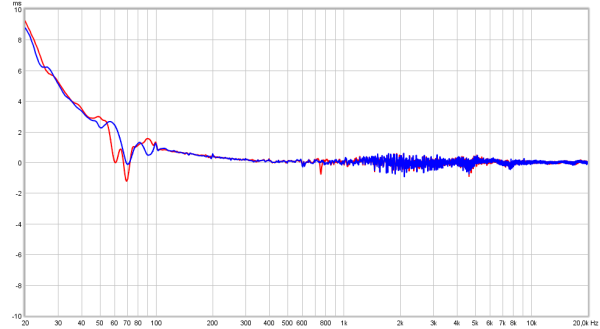 Around 70Hz there is a minimal amount of ‘pad bounce’. Basically a resonance frequency in the pads. Above 100Hz the response is flawless. One can ignore the ‘grass’ between 1kHz and 6kHz these are outside room noises at a very low level and not from the headphone itself.
Around 70Hz there is a minimal amount of ‘pad bounce’. Basically a resonance frequency in the pads. Above 100Hz the response is flawless. One can ignore the ‘grass’ between 1kHz and 6kHz these are outside room noises at a very low level and not from the headphone itself.
Below the CSD (Waterfall plot) of the HD660S2 (Left and Right are overlaid)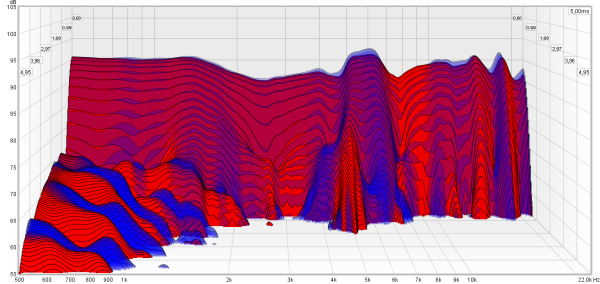 There is a resonance at around 5kHz. It is very short lived and not audible as such.
There is a resonance at around 5kHz. It is very short lived and not audible as such.
The CSD shows excellent impulse response with fast decay.
Another form of looking in the time domain is the spectrum plot. The amplitude is color coded and both the time scale and frequency scale differ as well.
Below the spectrum plot of the HD660S2 (right channel)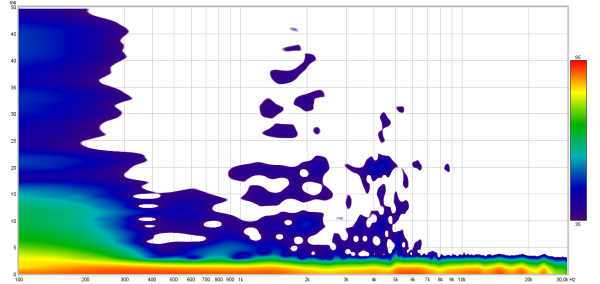 This plot too shows excellent impulse response even below 300Hz. The blue ‘islands’ between 1khz and 10kHz are not something in the headphone but are, very soft, external noises in the room. Because this is an open headphone those soft sounds are registered.
This plot too shows excellent impulse response even below 300Hz. The blue ‘islands’ between 1khz and 10kHz are not something in the headphone but are, very soft, external noises in the room. Because this is an open headphone those soft sounds are registered.
Below the step response with a dB scale (so not similar to an oscilloscope plot which has a linear scale). The step response (Left and Right) 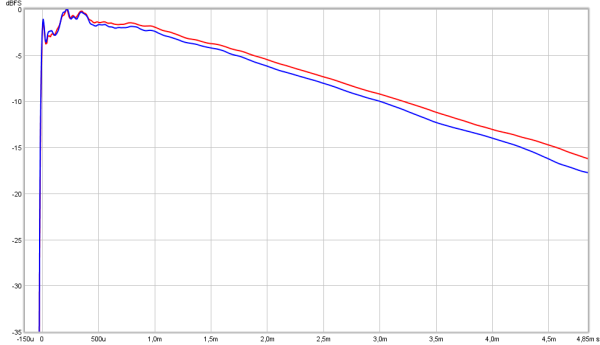
The rising edge almost reaches 0dB. The decay after 1ms is very gradual and shows decent low frequency response but just a little low in level. There is almost no ringing so the damping of the membrane is excellent. Headphones that are more ‘lively’ often show a lot of ringing. Usually a sign of excellent sound quality.
square-wave and impulse response
Below some measurements of a 40Hz and 440Hz square-wave and a 100µs impulse on the HD 660S2.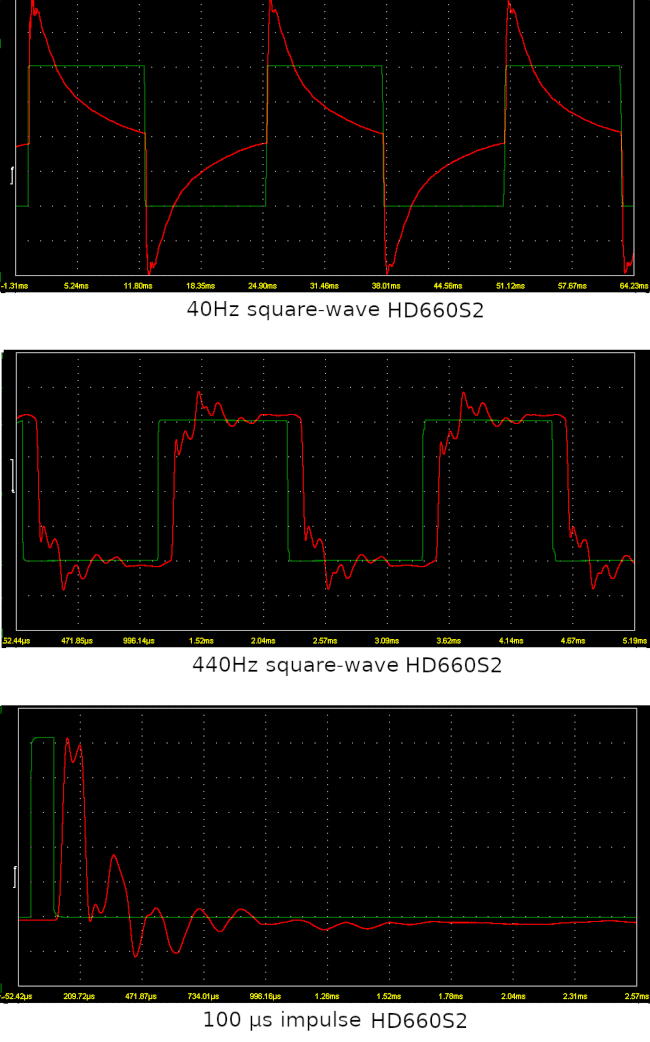 The 40Hz square-wave shows rolled-off bass extension indicated by the steep downward slope of the ‘horizontal part’ of the applied signal. When there is good bass extension the slope is more gradual and less.
The 40Hz square-wave shows rolled-off bass extension indicated by the steep downward slope of the ‘horizontal part’ of the applied signal. When there is good bass extension the slope is more gradual and less.
The 440Hz square-wave shows good tonality albeit with a lower clarity and slightly subdued treble but otherwise still looks close to the applied test signal.
The 100µs impulse almost reaches the desired level, is nice and sharp looking and has some minimal ringing after the pulse is gone. The driver seems fairly well damped.
The time difference between the stimulus and measured signal is caused by the speed of sound and the distance between the driver and microphone.
pads
Below a small experiment to see how different the newer (2020) pads from Sennheiser are from the older Sennheiser pads. The recent pads have a different foam, foam shape and different velours.
Stock HD660S2 versus the same headphone but fitted with (pretty new) HD650 pads.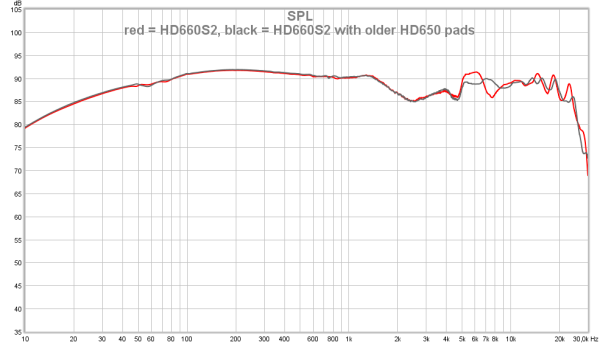 Interestingly the 6kHz peak is lower (not audible as such) so another experiment was to fit the HD660S2 pad on the HD650, this is shown below.
Interestingly the 6kHz peak is lower (not audible as such) so another experiment was to fit the HD660S2 pad on the HD650, this is shown below.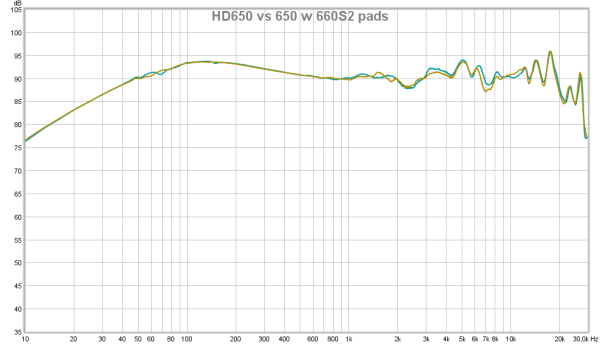 There seems to be no difference here so these pads are inter-changeable. The HD650 pads are 2 mm less thick than the HD660S2 pads.
There seems to be no difference here so these pads are inter-changeable. The HD650 pads are 2 mm less thick than the HD660S2 pads.
pad compression
Over the years the foam in the pads looses firmness and compress a little easier under the same pressure. This brings the drivers a little bit closer to the ear. To simulate this the pads are compressed a bit using Velcro-band around the drivers that presses the cups a bit more onto the test fixture.
This is not exactly the same as pad wear as the foam acts differently but it does give an idea about what will happen over years of usage to the tonal balance.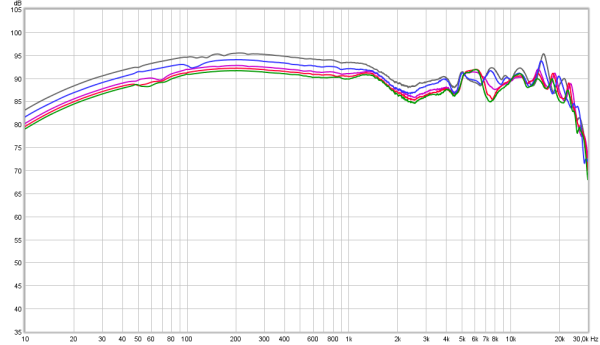 Above: pads not compressed (22mm), lightly compressed to 21mm, compressed to 20mm, compressed to 17mm, compressed to 13mm.
Above: pads not compressed (22mm), lightly compressed to 21mm, compressed to 20mm, compressed to 17mm, compressed to 13mm.
The effect is similar as observed with the HD650. Slowly over time the sound will loose clarity.
Also the 5kHz ‘bump’ disappears.
Clamping force
The clamping force, the force that pushes the headphone onto your head, is on the high side out of the box. 6 Newton (0.6kg) is way too much. The clamping force can be lowered by storing it on a stack of books. That will loosen the vice-like grip after a few days.
A quicker method is shown below. Extend the headband. Bend the steel part only. Do NOT put any force on any of the plastic parts. ONLY the steel parts need to be bent. Note it takes some force otherwise it will go back to the original position. Do this on both sides of the headband. Do this in small incremental steps and try it on to see if more bending is needed. The steel can always be bent back in shape if needed.
summary
At € 600.- the Sennheiser HD660S2 certainly is not the cheapest headphone around. For that money you get an ‘ordinary looking’ headphone with good comfort (when the clamping force is reduced) which does not have an absurd weight. You can keep this headphone on the head for hours.
This headphone excels in not being able to excel in anything specific…. if that makes sense.
It is not impressive in the lows (no Harman bass levels). It is not a super ‘dynamic’ headphone. It doesn’t have an exceptional stereo image/head-stage. It doesn’t have hyper detail and ‘airy’ sound.
It just is very good at sounding ‘pleasant’ and not doing anything wrong (except maybe bass extension).
It sounds ‘ordinary’ at first listen but is very good at it. Distortion free, no thumping bass, silky smooth treble, no shouty or sharp mids, no coarse or muffled sound.. it is just … nice… and ‘polite’ as in not ‘offensive’ in any way. Pleasant/musical would be a good description of the sound quality.
If that’s what you are looking for then the HD660S2 will do more than just fine.
It does not need EQ, unless you want Harman compliant bass or hyped treble or want a bit more clarity in some recordings.
Just plug it in your headphone amp (does not need to have more than 0.2W in power) and enjoy the music.
It can be used directly from a phone/tablet/laptop but requires the usage of the 3.5mm converter cable. It won’t play impressively loud in that case but loud enough for all day listening and even louder.
It does not need a powerful amplifier at all. As the 6.3mm TRS cable is 4-wire there is no real benefit in balanced usage.
5V (100mW in 300Ω) is all that is needed, maybe 8V (200mW) when desiring Harman bass at impressive levels.
There is no need to replace your HD660S with the HD660S2 though. They are more similar than different with just slightly more treble in the HD660S2. The extra few dB bass extension isn’t as audible as the advertising claims.
When you love your HD58X yet you really wanted a small increase in sound quality and are willing to fork out a substantial amount the HD660S2 may be an idea. It may not be worth it to some so don’t expect an incremental step in quality.
The HD660S2 also is not a replacement for HD600 and HD650 either. It is a different headphone, but not enormously different. It still has the typical ‘Sennheiser sound’ but is a bit more ‘relaxed’ in clarity.
When looking for an open headphone in the same price range but wanting a bit more ‘body’ and bass extension (without resorting to EQ) the OLLO S5X is an option.
Other good sounding headphones are the Focal Clear, HIFIMAN Edition XS and Meze 109Pro. These do not sound the same though but are similar-ish in overall sound quality.
Cheap alternatives, other than the HD58X is the HD560S. The latter has more bass extension (not more bass!), more clarity and better stereo imaging.
Also HIFIMAN HE400SE, Sundara and Beyerdynamic DT900ProX qualify as possible good sounding alternatives. They do not reach the sound quality of the HD660S2 though but do have other traits that make them interesting.
in short:
The HD660S2 is an fairly high priced open over-ear headphone that stands out in the fact that nothing really stands out and it doesn’t do much wrong. It does a lot right but is not ‘perfect’.
It requires a decent music source (headphone out) but does not need a lot of power so no need for kW amplifiers.
Harman type bass lovers will be disappointed. So will people that love elevated treble.
Smooth, accurate, low distortion, pleasant sound.
Good comfort (lower the clamping force) and parts will be available for years to come.
back to Sennheiser
back to measurements
home

thank you for sharing your work with us!
your comparison to the rest of the HD6 series made me think about how subjective sound perception can be
I bought the HD600 after years of owning the HD660s, I was expecting it to solve my main grievance with the later which was the subdued treble. to my surprise, and in spite of the popular consensus it sounded under detailed and cluttered in comparison. it definitively had more volume in the treble and a bit more in the bass. but somehow the 660s sounds cleaner and more airy (still lacking a lot of volume in the treble thoug IMO). I think the 600 sounds generally pleasant across any genre even before EQ but it wasn’t the holy grail I was hoping it to be while looking at the graph.
looking at your measurements, the 660s2 looks like a definitive improvement over the regular 660s but that price is not very enticing. speaking of pricing, while the 660s where 500€ at launch nowadays they are consistently under 400€ in Amazon and other big vendors
I would expect the HD660S2 price to drop to around € 500.- or just under after a while. The HD660S may well be dumped in the coming year (new as well as 2nd hand).
The HD660S2 sounds more ‘relaxed’, ‘smooth’ but also has less ‘clarity’ compared to the HD600.
The reason for why you find the 660s to have more clarity than the 600 might be found in the mid-bass of the 600. The way you perceive sound in the treble area is not coming only from the higher frequencies, but also from the total tonal balance. Having a transition with more overlap in the lower regions may have an effect on the clarity higher up.
I have the 650, and while I do not find it to be a headphone with superb clarity, it does have superb treble extension and treble detail. Not necessarily treble volume, admittedly. 🙂
I am one of those who swear by pairing it with a valve amplifier though. The Schiit may give it sufficient volume, but it sounds like the headphone is wrapped in a sock.
Excellent review that covers much of the technical aspects but also describes very well what this headphone is. I am a little surprised that the much talked about bass extension isn’t quite as good as hoped for. I was also surprised Sennheiser went back to 300Ω for this model. I’d associated 150Ω with the HD660 series. The review alludes to its ‘ordinary’ sound and it appears to be a headphone that ‘gets out of the way’ which has been a trait of this series which is very difficult to achieve, with little need for filters, modification or EQ. Like the alternating FR comparison, some sights in there like AKG’s K702.
I got these the moment they came out, since I’d heard the 660s and thought “well if it’s just more of this but slightly better sign me up.” I’ve had the 58x and 650, too. I’m in the camp voting 660s2 as the best iteration of this line of headphones. It does every genre I throw at it, and never sounds “wrong.” EDM, orchestral, acoustic, funk, synthwave, it handles all of them and makes them a pleasure. Glad to read a review that didn’t harp on the “unboxing experience.” I know no headphones are perfect, but these are the best, most natural sounding pair I’ve ever owned. For that alone, they’re worth the price imo!
Hi Solderdude, how do the HD660S2 compare to the X2HR? Which one sounds better in your opinion?
The X2HR is more dynamic, better 3D sound imaging and more treble. The HD660S2 is more relaxed, more stable (but narrower) imaging and overall better in sound quality but with less bass extension. Substantial price difference though. For the X2HR there are no spare parts, the HD660S2 will be supported for many years to come.
First, thank you for your detailed reviews. I always find the comparisons most interesting because while your absolute impression of a single headphone will probably be different from mine, comparison introduces one or several benchmarks for orientation.
No, in the comparisons here you only talk about “more bass extension”, butter what about less warmth, more detail/ transparency and stage-width? Which contestant will provide that over the Senn?
The more bass extension is about HD660S2 compared to HD660S. Also the HD660S2 has a wee bit more treble.
Stage width is the same for me. The problem with headstage is that not everyone perceives headstage the same. See:
https://www.audiosciencereview.com/forum/index.php?threads/how-do-you-hear-headphone-soundstage.37999/
Great Post !
Solderdude, can i ask for a your EQ profile setting for HD 660s2. format like below …
Preamp: -3.5 dB
Filter 1: ON PK Fc 10 Hz Gain 6 dB Q 0.7
Filter 2: ON PK Fc 380 Hz Gain -2.5 dB Q 1.2
Filter 3: ON PK Fc 750 Hz Gain -1.8 dB Q 2
Filter 4: ON PK Fc 1250 Hz Gain 1 dB Q 1.41
Filter 5: ON PK Fc 1500 Hz Gain -1.7 dB Q 4
Filter 6: ON PK Fc 2300 Hz Gain 2.5 dB Q 1.2
Filter 7: ON PK Fc 5000 Hz Gain 3.8 dB Q 1.2
Filter 8: ON PK Fc 6050 Hz Gain -5 dB Q 6
Filter 9: ON PK Fc 15000 Hz Gain -2.5 dB Q 2
These kind of filters usually are computer generated from measurements taken on some industry standard measurement fixture. I do not have such a fixture and also not that computer program.
If anything I would shelf the low bass a few dB and perhaps add 2 or 3 dB around 3kHz and play a bit with the Q value between 0.5 and 1.
You say “the HD560S has more bass extension (not more bass!), more clarity and better stereo imaging.” I wonder what if anything is better on the 660s2?
Thanks for your work!
You say “the HD560S has more bass extension (not more bass!), more clarity and better stereo imaging.” I wonder what if anything is better on the 660s2?
Comfort (when the clamping force is lowered) and the HD660S2 is less bright and has ‘silkier’ treble. This is not something that is visible in graphs.
HD560S extends deeper in the lows but HD660S2 is a bit ‘warmer/fuller’ in the bass/lower mids.
When one already owns the (>2022) HD560S then also owning a HD660S2 is not very useful.
When choosing between the 2 and not EQ’ing the HD660S2 has slightly better sound quality and comfort.
Hm… maybe for someone coming from a DT880 and in his mid 60s the 560 is not such a bad idea. More brightness might actually be quite welcome.
The >2022 HD560S is not bright, the early HD560S was a bit but only between 4 and 7kHz. The DT880 is sharper sounding and is so above 6kHz.